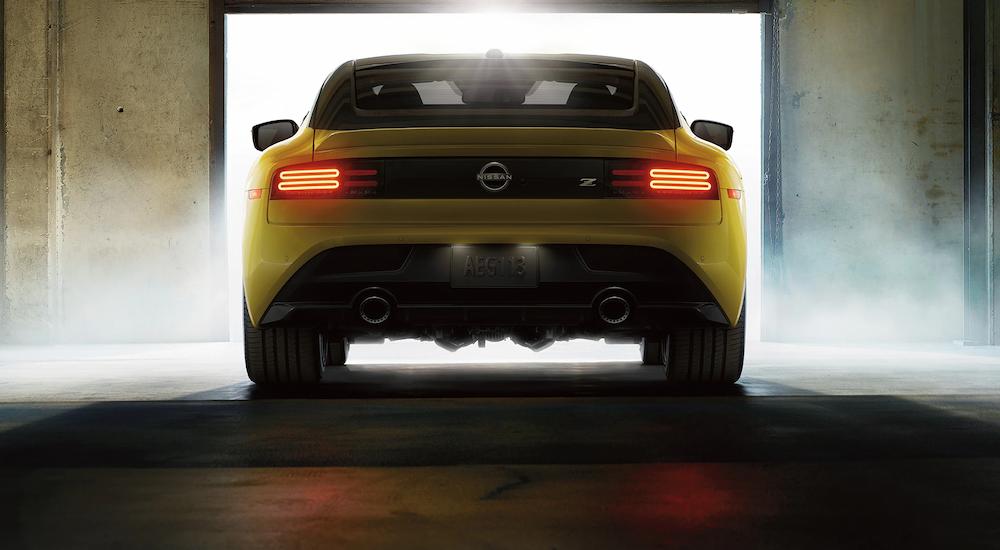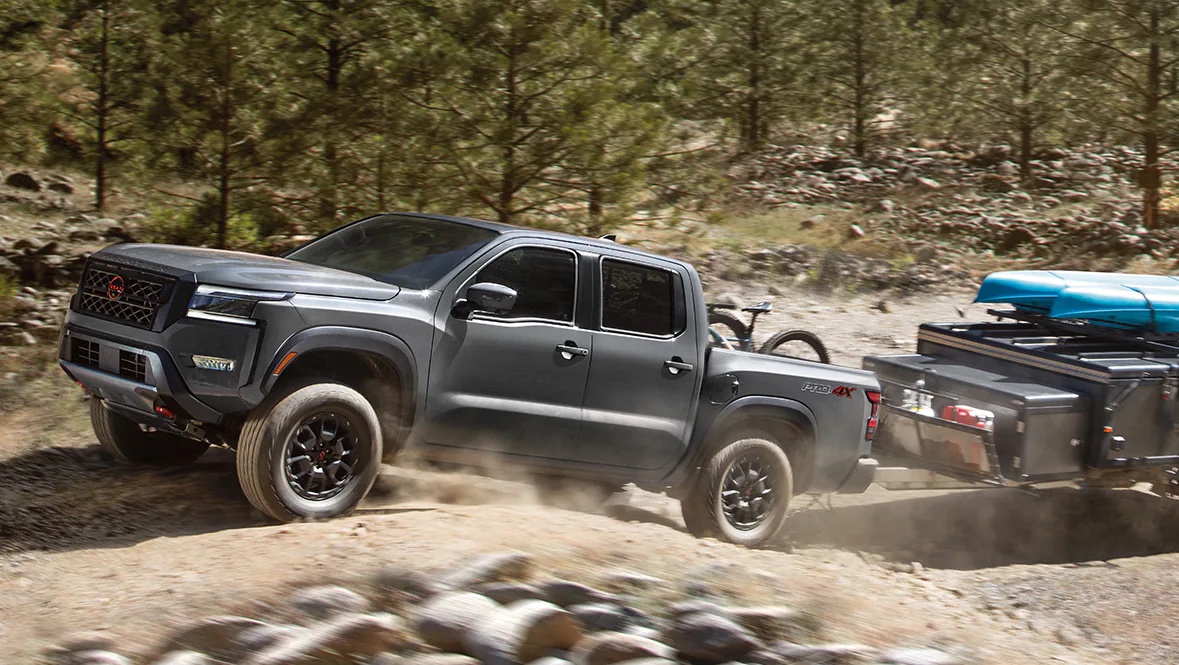While most drivers are quick to look at the engine under the hood and its specs, others know the value of digging deeper to see how the automaker improves the engine’s power delivery to enhance performance and control behind the wheel. In other words, will the engine deliver enough power to make the vehicle agile at higher speeds and stable in slippery or hazardous conditions? Automakers like Nissan achieve this feat by equipping their models with one of four drivetrains: front-wheel, rear-wheel, all-wheel, and four-wheel drive.
But what’s the difference between these systems? How do you know the best one for your driving needs? How is all-wheel drive different from four-wheel drive? Most importantly, how will these systems affect your Nissan service needs as you protect and maintain your investment year after year? It’s time to find out.
Front-Wheel Drive
Front-wheel drive is the most popular choice among automakers because its lightweight and compact design make it incredibly versatile, inexpensive to manufacture, and affordable to maintain. These characteristics make it a standard for most passenger vehicles, from sedans like the Altima to SUVs like the Rogue. In fact, 10 of Nissan’s 16 models come in front-wheel drive. But how does it work, and what other advantages does it offer?
A sedan like the Altima isn’t destined for the trail, nor is it expected to deliver extreme track-like performance. Instead, it sticks to the pavement as an everyday driver, so a front-wheel drivetrain is adequate. The drivetrain sends power to the front wheels, relying on only two wheels to steer and propel the vehicle.
Advantages and Disadvantages
This simple design is advantageous for many reasons. First, it positions the powertrain above the front wheels, naturally enhancing traction and freeing up space for automakers to offer more passenger and cargo room in the cabin. Second, front-wheel drive isn’t complex, which contributes to its affordability to manufacture. Automakers pass those savings to consumers, who enjoy additional benefits since front-wheel drive models are also typically more affordable to maintain.
While these factors are appealing, front-wheel drive has limitations if you’re looking for a capable hauler or sport-like performance. For example, positioning most of the weight at the front of the vehicle makes it harder for a front-wheel drive model to deliver off-the-line acceleration. This eliminates the sporty performance that many drivers desire and dramatically reduces a model’s towing capacity.

Rear-Wheel Drive
What do the Nissan Titan, Z, and Armada have in common? They all offer rear-wheel drive. Rear-wheel drive is another two-wheel drive option typically found on full-sized trucks, sports cars, and truck-based SUVs. While front-wheel drive relies on the front wheels to propel and steer the vehicle, a rear-wheel drive vehicle splits these responsibilities and shifts power delivery. Instead of sending power to the front, a rear-wheel drivetrain sends power to the rear wheels. As a result, the back wheels power the vehicle and free up the front wheels to focus on steering.
Advantages and Disadvantages
The transfer of power to the rear wheels improves how the vehicle handles and responds, positively impacting acceleration and towing capability. A rear-wheel drive vehicle is usually more engaging to drive because, unlike a front-wheel drive model, the weight is evenly distributed across the vehicle. It can also tow heavier loads because the power at the rear wheels is closer to the load.
However, there are a few disadvantages to a rear-wheel drive model. The positioning of the powertrain takes up more space, often reducing cabin volume and directly impacting passenger and cargo capacity. In many instances, this sacrifice isn’t an issue because rear-wheel drive vehicles either have large footprints (trucks and truck-based SUVs) or are designed for performance and not practicality (sports cars).
All-Wheel Drive
Nissan’s Intelligent All-Wheel Drive system blends the efficiency of two-wheel drive with four-wheel drive capability. But how does it accomplish such a feat? And what impact does it have on models like the Nissan Rogue, Murano, and GT-R?
Unlike front-wheel or rear-wheel drive, all-wheel drive focuses on distributing power to all four wheels. The key difference here is that Nissan’s Intelligent All-Wheel Drive technology constantly monitors the road conditions and looks for wheel slippage. Then, once conditions change or it detects tire spin, it distributes torque to the axle with traction to help you maintain control.
Advantages and Disadvantages
Automakers like Nissan typically offer all-wheel drive as an upgrade on sedans and crossovers that come standard with front-wheel drive. It can also be found in high-performance sports cars like the Nissan GT-R. Why? All-wheel drive offers many advantages because it actively improves how a vehicle performs and handles in any condition. In addition, there’s no manual adjustment or tweaking necessary because it’s constantly working behind the scenes.
Because an all-wheel drivetrain is continuously working, it’s advantageous in areas where conditions can change quickly. For example, Nissan’s Intelligent All-Wheel Drive constantly monitors the road, detecting wheel slippage when you leave the pavement to travel down a dirt road or struggle to accelerate in snowy or icy conditions. Unlike a four-wheel drive model, you don’t have to switch the vehicle into 4WD to maximize traction; instead, the all-wheel drive system makes the necessary adjustments as you focus on the road.

Four-Wheel Drive
While many all-wheel drive models can tackle slippery terrain, they can’t match the capability of a truck like the Frontier or Titan with four-wheel drive. But what’s the difference? Although both drivetrains send power to all four wheels, a four-wheel drivetrain offers more capability and is designed for extreme conditions and technical terrain.
Unlike all-wheel drive systems that constantly read and respond to the conditions, most four-wheel drive systems rely on the driver’s input. For example, once you leave the pavement and hit the trail, you have to switch to 4WD using a lever, button, or dial. This locks the front and rear axles together, making sure that your wheels keep turning no matter the conditions.
Nissan’s four-wheel drive models offer two-speed transfer cases, which means you can tailor the system’s response using 4HI and 4LO settings. While 4HI offers an even power delivery across both axles, 4LO increases torque output to deliver the necessary traction when tackling technical conditions at low speeds.
Advantages and Disadvantages
Four-wheel drive vehicles are staples among off-roaders and those who frequently drive in slippery conditions like ice and snow. Although four-wheel drive systems offer greater traction and more stability than any other drivetrain option, there are several disadvantages. The additional weight can dramatically impact fuel economy and extend your stopping distance. It can also damage your vehicle if you use four-wheel drive when navigating dry roads, limiting the versatility of this drivetrain in most daily conditions.
Choosing the Best Drivetrain
While it’s critical to consider how much power an engine delivers, it’s even more essential to look at how that power is delivered via the drivetrain. Front-wheel and rear-wheel drive models rely on two wheels to power the vehicle, but they do so in vastly different ways. Front-wheel drivetrains are more affordable and practical, but rear-wheel drive models are sportier and more engaging. Likewise, all-wheel and four-wheel drivetrains deliver power to all four wheels to improve traction, but how they do so is different. Whereas all-wheel drive constantly works in any condition, four-wheel drive is engineered for extreme conditions and often relies on driver input.
As you look at these options, consider the required Nissan service that comes with the different types of drivetrains. Front-wheel drive is standard across the industry and is affordable to maintain and service because of its simple designs. All-wheel and four-wheel drive is a more expensive investment that can be costly to maintain because of its complexities, many critical components, and the higher likelihood that you’ll spend more time in hazardous conditions. Determining if that capability outweighs the investment comes back to evaluating your driving style and needs.

